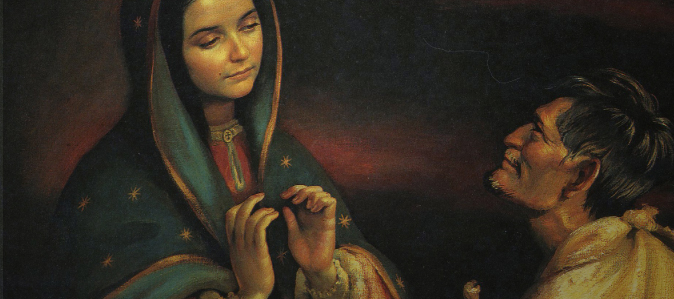One of the ways to prove the Catholic claim is through miracles. Catholicism, unique amongst all the faiths on Earth, has colorable claims of miraculous events with evidence. One of these miraculous events is Our Lady’s appearance to St. Juan Diego from December 9th to the 12th of 1531. You can find the full story here. And here’s her image on the tilma of St. Juan Diego.
Now, there have been serious questions about whether this apparition is real. I firmly believe it is, and the Church canonized St. Juan Diego, suggesting She does as well. The arguments against the apparition become less compelling when you try and piece them together. For example, it’s claimed that since the Spanish didn’t write about this event for over a decade (which is apparently true: the first existent writing we have from the Spanish is from 1548), then it didn’t exist. But given that the Spanish were often clueless about Aztec life, and didn’t speak the Nahuatl language, this isn’t a particularly troubling occurrence. There’s little question that this was a devotion popular amongst Aztec converts, rather than Spanish cradle Catholics. And while the Spanish don’t write about the apparition (at first), there is plenty of historical evidence that after 1531, the number of Aztecs seeking Baptism jumps through the roof: As Called to Communion explains:
“This miracle precipitated the greatest flood of conversions in the whole history of Christianity. In the seven years following this miracle, approximately eight million Aztecs converted to Christianity […]
Prior to this event, the Aztecs were offering thousands of human sacrifices per year in central Mexico, including child sacrifice. The conversion of the Aztecs to Christianity ended the brutal practice of human sacrifice, and helped bring Central and South America to Christianity.”
Then there’s also the fact that Santa Maria de Guadalupe is a religious devotion amongst the Spanish, leading other critics to claim that the Spanish made this myth up to convert the Aztecs. This theory makes the most sense of the critical ones, but it doesn’t hold water. As we just established, the Spanish seemed unaware of the devotion in its early days. Surely, if they were the ones spreading it, we’d see some documentation that they were – something in a diary about how they were explaining the Virgin of Guadalupe to the Aztecs. There’s nothing of the sort. Instead, many of the earliest Spanish writings are skeptical, while it’s the Aztecs themselves who are the believers. Besides this, fiber testing shows that this tilma isn’t Spanish in origin, but is made from Mexican hemp.
The picture that emerges is a fascinating one. It seems too Mexican to be Spanish, and too Spanish to be Mexican. And it’s far too Christian to be a warmed-over Aztec goddess cult, one of the other theories. Called to Communion notes:
“The image shows Mary as a humble but royal maiden. Under her feet is the Moon, which for the Aztecs represented the devil. In this way the image depicts Mary as crushing the head of the serpent, and corresponds to the description of the woman described in Revelation 12.”
Consider this for a moment: Mary and Her Seed, Christ, are depicted stepping on the head of Satan in Genesis 3:15. Later, She’s depicted as pregnant with Jesus stepping on the moon in Revelation 12:1. Neither the Spanish nor the Aztecs made these accounts up. They’re from separate Books of Scripture, and each predate the apparitions by well over a millenia. Yet given the Aztec symbology, with its curious identification of the moon with the devil, this image served as beautiful exegesis explaining Mary’s Biblical role in salvation. As an added twist, the Nahuatl word Coatlaxopeuh, which is pronounced like Guadalupe, means something like “One who crushes serpents” [Coa(serpent), tla (the), xopeuh (crush, stamp out)], again supporting that the one who appeared to St. Juan Diego was truly Mary, and not something sinister.
It’s not just the moon She’s standing on, either. A Canadian Catholic paper, Western Catholic Reporter, had a fascinating article (a copy of which can be found here) on the work Prof. Victor Campa Mendoza had done showing the tilma’s authenticity:
“According to the Nahualt culture, Juan Diego’s culture, Our Lady is pregnant in the tilma. This is clear by the shape of her waist and by the four-petal flower resting on her womb, which in Nahualt culture is a symbol of pregnancy, Mendoza said […]
Mendoza noted Our Lady’s tilma shows the radiant rays of the sun surrounding her as she appeared, wearing a blue-green mantle that depicts the universe.
Also fascinating is the pattern of stars strewn across her mantle. According to Mendoza the pattern mirrors the exact position of constellations on the day her image appeared on the tilma, Dec. 12, 1531. He used a graph to prove it.
It has been found that by imposing a topographical map of central Mexico on the Virgin’s dress, the mountains, rivers and principal lakes coincide with the decoration on this dress, he said.”
So for this to be a forgery, the forger would have had to not only be a masterful artist, painting something so beautiful on hemp (instead of campus), but also be well-versed in Scripture, Aztec culture and symbology, Mexican topography (and not just the area around Guadalupe, but all of central Mexico), astronomy, and Spanish religious devotions. Or we can just accept that this is plainly miraculous, and an event which led to the salvation of millions of souls, those very souls which seemed most lost to satanic forces. At some level, “skepticism” simply requires a level of incredulity that belief doesn’t.
